
FTU Working Paper Series, Vol. 1 No. 1 (01/2022) | 81
THỰC TIỄN GIẢI QUYẾT TRANH CHẤP VỀ CHỐNG BÁN PHÁ GIÁ
TRONG KHUÔN KHỔ WTO
Đỗ Thị Phương Thảo
Sinh viên K56 CTTT Kinh tế Đối ngoại – Viện KT&KDQT
Trường Đại học Ngoại thương, H Ni, Việt Nam
Ngô Hong Qunh Anh
Giảng viên Viện KT&KDQT
Trường Đại học Ngoại thương, H Ni, Việt Nam
Tóm tắt
Bài viết đi sâu vào khía cạnh lý thuyết và thực tiễn của việc giải quyết tranh chấp chống bán phá
giá trong khuôn khổ Tổ chức Thương mại Thế giới (WTO), cũng như nghiên cứu và phân tích
về vấn đề này. Với khoảng 20% thành viên WTO tham gia, thực tiễn giải quyết tranh chấp chống
bán phá giá tại WTO không chỉ cho thấy sự gia tăng về số lượng mà còn thể hiện sự phức tạp
của các tranh chấp chống bán phá giá. Thực tiễn giải quyết các tranh chấp chống bán phá giá tại
WTO đã chứng minh rằng chủ yếu là các thành viên phát triển hoặc một số thành viên đang phát
triển có tiềm lực kinh tế mạnh mới có thể theo đuổi cả một qui trình giải quyết tranh chấp kéo
dài của WTO.
Từ khóa: Chống bán phá giá, Cơ chế giải quyết tranh chấp (DSM), Tổ chức Thương mại Thế
giới (WTO).
PRACTICE OF DISPUTE SETTLEMENT AT THE WTO ON
ANTI-DUMPING
Abstract
The article delves into the theoretical and practical aspects of anti-dumping dispute settlement
within the World Trade Organization (WTO) framework by implementing research and analysis to
take a deeper into it. With about 20% of WTO members participating up to now, the practice of
settling anti-dumping disputes at the WTO shows not only an increase in the number, but also in
the level of complexity of anti-dumping disputes. The practice of resolving anti-BPG disputes at
the WTO has demonstrated that only a few developing members, if any, have the economic capacity
to pursue a lengthy WTO dispute resolution process.
Key words: Anti-dumping, Dispute Settlement Mechanism (DSM), WTO framework.
Working Paper 2022.1.1.06
- Vol 1, No 1

FTU Working Paper Series, Vol. 1 No. 1 (01/2022) | 82
1. Introduction
Anti-dumping disputes are becoming increasingly complicated and popular in today's
international trade as more countries, primarily developed countries, impose anti-dumping
measures. By definition, anti-dumping measures are both as a trade barrier and a form of domestic
industry protection. Between January 1st, 1995, and December 31st, 2020, 6300 new anti-dumping
investigations were launched, with 4071 anti-dumping measures implemented by WTO members.
Anti-dumping investigations and the following measures imposed by WTO members,
consequently, have become even more complex and challenging to manage.
More than one hundred WTO members had a legal framework for anti-dumping investigations
by the end of December 2020, while more than half of them executed anti-dumping investigations
each year. WTO members have proactively used appropriate mechanisms to protect their
legitimate rights and interests in the face of the aforementioned situation. The DSM of the WTO
is currently one of the most effective. However, there are several flaws in the WTO's DSM and
the resolution of anti-dumping disputes that must be addressed.
As a result, I decided to choose the topic and title "Practice of WTO Dispute Settlement on
Anti-dumping" for my paper.
2. A brief overview of the practice of dispute settlement at the WTO on anti-dumping
2.1. Overview of Dispute Settlement Mechanism (DSM) at the WTO
a. Objectives of the DSM
The Dispute Settlement Mechanism in the WTO is the successor to the provisions on dispute
settlement that have had a positive effect over the past 50 years in the history of GATT 1947.
Learning from the inadequacies in the old mechanism, a number of fundamental improvements to
the procedure have been incorporated into the new mechanism, significantly contributing to
enhancing the adjudicative nature of this procedure as well as enhancing the binding of dispute
settlement decisions.
The fundamental objective of the DSM in the WTO is to “achieve a positive solution to the
dispute”, and to give priority to “solutions mutually agreed upon by the disputing parties and in
accordance with the Agreements”. On a broader scale, this mechanism is intended to provide
multilateral dispute settlement procedures as an alternative to unilateral actions by member states,
which pose many risks of injustice, stagnation and disturbance mixing the common operation of
international trade rules.
b. Legal framework and sources
On the basis of the discrete provisions on dispute settlement in GATT, the WTO has
succeeded in establishing a complete and detailed legal mechanism in a unified document to settle
commercial disputes among WTO members (including sovereign states and separate customs
territories):
• Agreement on Rules and Procedures Governing Dispute Settlement (DSU)
• Appendix 2 to the Marrakesh Agreement establishing the WTO.
In addition, this mechanism is also included in a number of separate provisions in other
documents (referred to by DSU) such as:

FTU Working Paper Series, Vol. 1 No. 1 (01/2022) | 83
• Articles XXII and XXIII of GATT 1947 (Article 3.1 DSU)
• Specific or additional rules and procedures for dispute settlement in WTO
Agreements (Example: Article 11.2 of the Agreement on Phytosanitary Measures; Articles
17.4 to 17.7 of GATT 1994...)
“Decision on Special Dispute Settlement Procedures” GATT 1966: includes rules applicable
to the settlement of disputes between a least developed country and a developed country (Article
3.12 of the DSU) and special procedures applicable to disputes involving a least developed country
party (Article 2.4 DSU).
This WTO’s DSM is obligatory for all member countries whereby each member has a
complaint or dispute with another member and is forced to bring the dispute to settlement by this
mechanism. The Member State complained against has no other option but to accept participation
in the settlement of the dispute under the procedures of this mechanism. This is the point that
makes the difference as well as the operational efficiency of the dispute settlement mechanism in
the WTO compared to existing international dispute settlement mechanisms (the settlement
competence of the traditional mechanisms not mandatory but subject to the approval of the
countries concerned).
c. Dispute Settlement Authorities
Dispute Settlement Body (DSB): This body is essentially the WTO General Assembly,
consisting of representatives of all member states. The DSB has the power to establish panels,
adopt panel and Appellate Body reports, monitor the implementation of decisions, recommend
dispute settlement, and authorize suspension of obligations. and make concessions (retaliation).
However, the DSB is only a decision-making body, not directly conducting the dispute settlement
review.
Panels: This panel consists of three to five members whose task is to consider a particular
matter in dispute on the basis of WTO rules invoked by the complaining country. The outcome of
the Panel's work is a report to be submitted to the DSB for adoption, which enables the DSB to
make recommendations to the disputing Parties. In fact, this is the body that directly resolves
disputes, although it does not hold decision-making power (because with the principle of veto
consensus, all dispute resolution issues that have been brought before the DSB are "automatically"
adopted).
The Appellate Body (SAB): The Appellate Body is a new body in the WTO dispute settlement
mechanism, allowing panel reports to be reviewed (when required), ensuring the correctness of
dispute settlement reports. The establishment of this body also shows more clearly the adjudicative
nature of the new dispute settlement procedure.
2.2. Current situation of anti-dumping disputes at the WTO
Throwing back to 25 years ago since the first case of anti-dumping dispute between Mexico
and Venezuela (DS23) [1] over some oil country tubular goods (OCTG) imported from Mexico, it
can be concluded that there are no specific or common characteristics of product types or countries
which have been or will be involved in anti-dumping disputes. However, over the last 25 year
period of resolving international trade disputes in general and anti-dumping disputes in particular,

FTU Working Paper Series, Vol. 1 No. 1 (01/2022) | 84
the WTO has partially met its members' demands for a clear DSM in a timely and effective manner
with several noticeable statistics as follow:
Regarding total cases, the WTO has settled a total of 137 anti-dumping cases during this time
period, making it the most common type of dispute in the WTO system. Nearly six hundreds of
consultation requests in total were sent to WTO members from 1995 to 2020 [14]. In the five most
recent years, 2018 was the year having the most cases (38 cases) and the number of disputes tended
to decrease considerably since then, with only 5 in 2020.
Figure 1. Requests for consultations (1995 – 2020)
Source: World Trade Organization
Regarding products involved in disputes, anti-dumping disputes within the WTO framework
mainly involve steel, seafood, mobile phones, footwear, textiles, pharmaceuticals, and other
commodity groups.
Regarding nations involved in disputes, the level of participation of developed and developing
WTO members as anti-dumping complainants and respondents differs significantly. Members of
the development team predominantly play the role of respondent, while those from the
development team often take the complainant side. Among those, the United States is the leading
country in the number of disputing cases with 54 totally (7 times as a plaintiff and 47 times as a
defendant).
Regarding specific matters of disputes and lawsuit, anti-dumping disputes are mainly
principles-related issues (Article 1 with 85 cases); determination of dumping (Article 2 with 49
cases, 57 disputes about the comparison between export price and normal value under Article 2.4);
evidence issue (Article 3 with 41 cases); and the best information issue (Article 4 with 41 cases).
Article 9 on anti-dumping duty taxation and collection was used in 31 cases, followed by Article
7 on provisional measures in 14 cases, and then Article 8 on the new price commitment measure
in four cases.
As a result, several observations can be drawn out from the current remarks of resolving anti-
dumping duty issues within the WTO including:

FTU Working Paper Series, Vol. 1 No. 1 (01/2022) | 85
First, anti-dumping disputes are by far the most common type of WTO dispute to be resolved.
This is due in part to countries' growing application of anti-dumping measures as a tool for
protecting local industries. As long as there are a lot of anti-dumping cases, there will be a lot of
conflicts which will get more complicated accordingly.
Second, the most common type of WTO anti-dumping dispute is around the official anti-
dumping duty. The following are the realizable reasons for this: (i) By nature, provisional measures
have limited impact due to their temporary validation and short-term application only within the
investigation period; (ii) The exporter has to agree on the price commitment measure, which should
be voluntary, but in practice, only a few companies are able to use this metric; (iii) Because most
members strive to ensure that their national laws are compatible with WTO law, disputes resulting
from other legal reasons like inconsistencies between a member's legal provisions and the Anti-
Dumping Agreement (ADA) content become less common; (iv) Anti-dumping duties, in the
meantime, are approved by the competent authorities and valid in the long run, which will
definitely cause real barrier and challenges towards import products.
Third, in terms of products involved in the disputes and subsequent lawsuits, they primarily
belong to the developing country members' export product groups that have competitive advantage
and strengths over the others’.
Fourth, under the Advisory Centre on WTO Law's advice and assistance, several developing
country members are becoming more active and enthusiastic in participating in resolving anti-
dumping disputes, inferring a sharp increase in their faith in the WTO’s DSM and their self-
confidence. Indeed, many cases have been documented since 1995 in which developing members
have emerged victorious. For instance, DS58 [2]: United States — Anti-dumping Measures on
certain Shrimp from Vietnam (Thailand), DS404 [7]: United States – Imported Shrimp (Vietnam),
DS345 [5]: United States — Customs Bond Directive for Merchandise Subject to Anti-
Dumping/Countervailing Duties, and so on. That active participation is worth encouraging as it
helps narrow down the discrepancy between the developed and these developing members.
However, the majority of developing members at the WTO still do not or only partially participate
in the settlement of international trade disputes, particularly anti-dumping disputes, perhaps due
to the lack of financial and human resources to pursue lawsuits, the lack of experience in dispute
resolution, and so on.
2.2. Some remarks drawn from the practice of settling disputes on anti-dumping within the WTO
framework
The following observations can be made about the practice of resolving anti-dumping duty
issues within the WTO system:
To begin with, anti-dumping disputes are by far the most common type of WTO dispute to be
resolved. This is due in part to countries' increased use of anti-dumping measures as a tool for
protecting local industries. As long as there are a lot of anti-dumping cases, there will be a lot of
conflicts, and they'll get more complicated.
Second, the most common type of WTO anti-dumping dispute is formal anti-dumping duty
disputes. The following are the main reasons for this: (i) Provisional measures have limited impact
due to their temporary nature; the exporter must agree to the price commitment measure, which is
voluntary. In practice, only a few companies are able to use this metric. Because most members


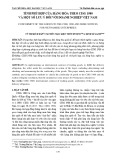

![Bài giảng Pháp luật Kinh tế - Tài chính 3 [mới nhất]](https://cdn.tailieu.vn/images/document/thumbnail/2021/20210325/kethamoi11/135x160/71616666328.jpg)
![Bài giảng Pháp luật Kinh tế - Tài chính 2 [chuẩn nhất]](https://cdn.tailieu.vn/images/document/thumbnail/2021/20210325/kethamoi11/135x160/2651616666331.jpg)
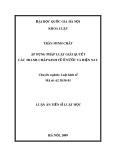
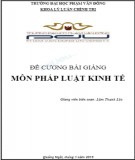

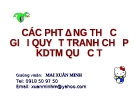

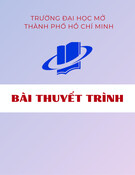
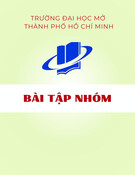
![Trắc nghiệm Luật Kinh Doanh về Hợp Đồng: [Kèm Đáp Án Chi Tiết]](https://cdn.tailieu.vn/images/document/thumbnail/2025/20251127/doduyphong911@gmail.com/135x160/14321764296608.jpg)












